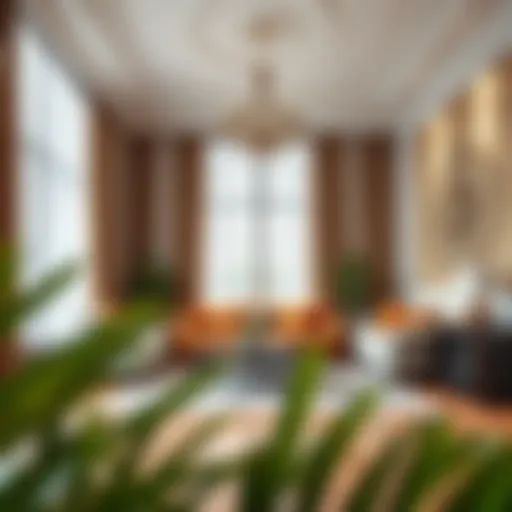Blending Style and Function: Pet-Friendly Entertainment Centers
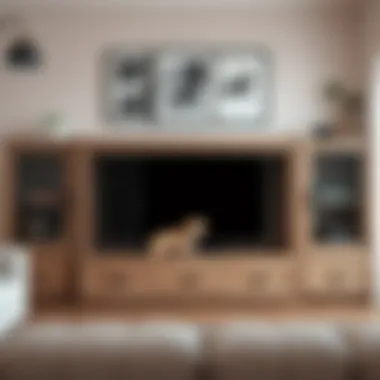

Intro
As the lines between style and functionality blur in today’s homes, more pet owners find themselves in a unique predicament: how to create a space that is both chic and accommodating for their furry companions. Today's homeowners are seeking innovative ways to integrate their pets’ needs into their living environments without sacrificing aesthetics.
The fusion of entertainment centers with dog cages represents this very ambition. By discerningly merging function and form, individuals can strike an elegant balance that not only enhances the living space but also ensures their pets remain comfortable and safe. Homeowners, interior designers, decorators, and related professionals must consider various elements—from styles and trends to practical selection tips—to successfully navigate this intriguing confluence of design and utility.
Let’s explore the various dimensions involved in this innovative integration, beginning with the furniture styles and trends that contribute to this unique approach.
Furniture Styles and Trends
Exploring Popular Furniture Styles
In the realm of interior design, furniture styles have evolved, adapting to the tastes and needs of homeowners. The integration of dog cages with entertainment centers often hinges on the style of the furniture selected. Various styles can harmonize effortlessly, creating a cohesive environment.
Among the popular styles:
- Modern: This style features clean lines and minimalist designs, often made from metal and glass. Modern entertainment centers can seamlessly conceal a cage without looking out of place.
- Rustic: With its use of natural wood and weathered finishes, a rustic design can evoke warmth. Choose wooden frames that blend well with soft colors, making a home feel inviting for both humans and pets.
- Industrial: Designed for an urban look, industrial furniture often utilizes raw materials. Incorporating a cage with an entertainment unit that has exposed metal can produce a unique, urbanized aesthetic.
Understanding Current Design Trends
Today's design trends lean towards multifunctionality. Homeowners appreciate the dual purpose of furniture that caters to multiple needs. Some trends to note:
- Multi-Functional Furniture: Items that serve more than one purpose are gaining traction—think entertainment centers with built-in storage and pet areas. This can be a major space-saver in small homes.
- Sustainable Materials: Eco-conscious consumers are gravitating towards products made from reclaimed wood and recycled metals. This trend not only enhances aesthetic appeal but also resonates with responsible pet ownership.
- Customization: Tailoring furniture to personal taste has become commonplace. Homeowners love the ability to design their own units, allowing for specific cage styles that maintain the overall design ethos.
"Today's design is not merely about how something looks; it's about how it functions in our lives. Harnessing the power of innovative design can transform our spaces and lives."
Practical Tips for Furniture Selection
Factors to Consider When Choosing Furniture
When pairing furniture styles with a dual function, several elements come into play:
- Size and Space: Assess the dimensions of your area. Ensure any entertainment center with a dog cage accommodates the available space without overcrowding it.
- Pet Safety: Look for materials and designs that keep your pets safe. Avoid sharp edges and small gaps that could cause harm.
- Aesthetics: Select colors and finishes that complement your overall home décor while ensuring that the piece is inviting rather than obtrusive.
How to Measure and Optimize Space
Measuring your space correctly can make all the difference:
- Take Accurate Measurements: Measure both the height and width of the intended location. Knowing how much room you have will narrow down your choices effectively.
- Plan for Accessibility: Consider how easy it will be for your pets to enter their space. Accessibility is key for their comfort and ease of use.
- Visualize with Layouts: Use software or apps to create mock-ups of furniture layouts. This can help visualize how an entertainment center can serve dual purposes without compromising aesthetics.
By carefully considering these aspects, homeowners can find a harmonious blend of style and practicality within their living spaces, ensuring both humans and pets feel at home.
Culmination
Combining an entertainment center with a dog cage is not just an innovative idea but a forward-thinking approach to home design. With careful consideration of styles, trends, and practical tips, the results can be transformative. As homeowners continue to search for ways to integrate their lifestyles with their pets, this dual-functionality concept holds immense potential for creating beautiful, functional living spaces.
Foreword to Multifunctional Furniture
In today's fast-paced world, the quest for space-efficient solutions has taken center stage in home design. Modern homeowners are increasingly faced with the challenge of creating a living environment that encompasses not only their individual tastes but also the practical needs of pet ownership. This need cultivates a growing interest in multifunctional furniture—pieces that embody both form and function. The integration of entertainment centers that double as dog cages serves as a prime example of innovative design responding to evolving lifestyle requirements.
These multifunctional items can significantly streamline living spaces, making them a far cry from traditional compartments that served only a single purpose. The benefits are manifold: they help save space, they can reduce clutter, and they foster a cohesive aesthetic throughout the home. Before diving into the specifics of combining entertainment centers with dog cages, it is critical to consider how this design paradigm not only meets functional needs but also enhances the visual appeal of a room.
The Rise of Dual-Purpose Furniture
There’s a noticeable shift in the furniture industry as consumer preferences evolve. Dual-purpose furniture has become more than just a trend; it's a necessity for many. Consider the well-known Murphy bed—once a quirky concept, now a must-have for city dwellers facing real estate constraints. Similarly, the integration of dog cages into stylish entertainment units reflects a larger trend toward functionality. This rise in dual-purpose design is driven by a collective need to maximize both living space and utility without sacrificing style.
Moreover, the growth of pet ownership—especially among younger generations—has put pressure on designers to craft solutions that honor both human and animal lifestyles. Homeowners want to create inviting environments that reflect personal style while accommodating their furry friends. The merging of entertainment centers and dog cages represents a natural evolution in furniture design, where pooch and owner can coexist harmoniously.
Catering to Both Aesthetics and Practicality
Finding the perfect balance between aesthetics and practicality can feel like threading a needle, but it's absolutely achievable. Multifunctional furniture pieces, especially those that combine entertainment centers and dog cages, exemplify this delicate balance. Imagine a sleek, modern entertainment unit that houses not only the latest in tech gadgets but is also an inviting space for your beloved dog.
When selecting designs, consider materials, shapes, and even colors. The goal is to create a unified look throughout the home. Here, furniture should not just exist; it should sing harmoniously in your living space. Moreover, durability becomes essential, particularly for items that are a home to pets. If you can find a structure that checks all the boxes—visually stunning, practical, and safe—you’ve hit the jackpot in modern home design.
By embracing these design philosophies, homeowners can enjoy their entertainment setups without sacrificing their pet's comfort. This integrated approach to living spaces allows for an environment where beauty meets necessity, ensuring that every member of the household, two-legged or four, can thrive.
Understanding Entertainment Centers
In today’s living spaces, the role of entertainment centers has evolved significantly. They are no longer just bulky structures designed to house televisions and audio-visual equipment; rather, they have transformed into focal points that blend aesthetics with impeccable functionality. An often overlooked aspect is the adaptability of these pieces, especially when considering their potential to double as enclosures for our furry companions.
Understanding the importance of entertainment centers lays the groundwork for appreciating their multifunctional capacity. Homeowners look for designs that cater not just to style but also to convenience. This dual need is where the significance of integrating dog cages within entertainment centers shines.


Design Variations and Styles
Design flexibility is a major player when it comes to entertainment centers. The market has seen a variety of styles emerging, from sleek modern designs made of glass and metal to traditional wooden pieces that exude warmth. This diversity allows homeowners to find something that speaks to their individual taste while also considering the functionality that the piece offers.
For example, rustic farmhouse styles may incorporate sliding barn doors, making it easy to access both the entertainment components and a cuddly occupant within the dog cage. On the flip side, minimalist designs often feature clean lines, focusing on a sleek aesthetic that won't overwhelm a small room.
Some popular design variations include:
- Modular Systems: These are customizable, allowing for easy integration of a dog cage. Homeowners can choose specific compartments for their electronics, while a cleverly disguised cage keeps their pet close by.
- Wall-Mounted Units: Space-efficient and visually appealing, these designs save floor space. One can tuck a small dog cage beneath the entertainment center, providing low visibility but easy access for the pet.
- Corner Units: Optimizing traditionally unused space, these can often incorporate rounded edges that minimize the risk of injury for pets.
In considering all these styles, it’s essential to remember that your choice should reflect not only your personal style but also provide a safe and inviting environment for your pet.
Functionality and Features
Entertainment centers are not just about what meets the eye; their functionality and features play a key role in their appeal. Storage, organization, and accessibility are fundamental aspects that contribute to a cohesive living experience.
When integrated with dog cages, functionality sees an entirely new dimension. Here are several significant features one might consider:
- Storage Solutions: Look for entertainment centers that provide drawers or shelves. This additional storage can hold everything from DVDs and video games to pet supplies like leashes and toys, creating a neat and organized environment.
- Cable Management: A modern entertainment center should have built-in systems for routing cables. This feature keeps the area tidy, eliminating unsightly wires that might pose a risk to curious pets.
- Flexible Configurations: Choices in design should accommodate different tech setups. Be it a large screen or gaming console, a well-designed center will have the capacity to fit changing technology needs while also being a comfortable space for a dog cage, potentially underneath or beside the main structure.
When selecting an entertainment center that can accommodate a dog cage, it's pivotal to consider size, shape, and design aesthetics. One should not compromise on style or utility, as both aspects are crucial for a harmonious living space.
In summary, understanding the nuances of entertainment centers is essential for making informed choices. These versatile pieces can cater to the functional demands of modern households while addressing the heartfelt need for pet-friendly spaces.
Exploring the Concept of Dog Cages
The concept of dog cages, often perceived simply as a necessary element for pet ownership, has evolved greatly in recent years. In the context of integrating them with entertainment centers, their significance expands into a multifaceted piece of furniture that satisfies both aesthetic and practical needs. Homeowners these days are increasingly looking to create spaces that not only accommodate their furry friends but also enhance their home’s visual appeal. When delving into dog cages, one must consider various factors, from design aesthetics to the fundamental purpose of a cage.
Traditional vs. Modern Dog Cages
When comparing traditional dog cages to modern alternatives, there’s a universe of difference. Traditional cages often take on a utilitarian flair, focusing more on functionality than fashion. They can be clunky, making them stand out in a home in a less-than-alluring way. Many of these classic designs are generally constructed from metal bars, lacking any form of aesthetic consideration. However, the more creative modern designs have transformed the concept of a dog cage into an elegant feature.
Modern dog cages come in various materials, shapes, and sizes. You can find options made from wood, which can blend beautifully with an entertainment center, giving it an integrated feel. Some designs even resemble stylish furniture, fitted with plush bedding and varying textures that invite the dog in, rather than pushing them away. The focus in modern designs is often on creating a cohesive piece that enhances home decor, allowing pets not just to be housed but to also become a part of the household aesthetic.
Key Differences:
- Design: Old cages often lack style, while contemporary ones offer design elegance.
- Materials: Traditional cages are mostly metal, whereas newer styles incorporate wood and fabrics.
- Functionality: Modern cages may come with added features like multi-level shelving or integrated storage space.
Safety and Comfort Considerations
Another area of prime importance in dog cages pertains to the safety and comfort of the pets themselves. Just because you are integrating a cage with an entertainment center does not mean the well-being of your pet should be compromised. Selecting a cage that provides ample ventilation while ensuring the pet's safety is vital. A solid construction without sharp corners is essential for preventing any injuries. It’s all about striking that careful balance.
When considering comfort, think about cushioning and space. A cozy bedding set can do wonders for turning a simple cage into a welcoming retreat for your furry companion. Rather than seeing the cage merely as a confinement area, it’s best to foster a warm space for dogs where they feel secure and at home, especially when integrated alongside family leisure areas.
Moreover, ensuring that the layout of both the entertainment center and the accompanying dog cage allows for easy access is fundamental. It’s essential for the owner to reach their pet with ease, and likewise for the dog to see what's going on. A sense of inclusion can help make your pet feel more relaxed.
"The key to a harmonious living space is ensuring that it accommodates not just the visual appeal of our surroundings, but also the well-being of our beloved pets."
In summary, understanding what dog cages have evolved into—both as functional spaces for pets and as stylish components of home decor—can enrich both life for you and your furry friend. The delicate interplay between functionality and aesthetics in this realm is essential for a contemporary lifestyle.
Innovative Design Solutions for Combined Spaces
As the dynamics of modern living space evolve, the call for innovative design solutions becomes all the more significant. The idea of integrating entertainment centers with dog cages not only caters to functionality but also speaks volumes about aesthetics and the way we view our environments. Homeowners are searching for ways to optimize small spaces while ensuring their furry friends are comfortable and safe. This necessity opens up the door to multifunctional furniture, which serves a dual purpose without compromising on style. It’s not just about saving space; it’s about creating a home that feels harmonious and inviting.
Integrating Dog Cages into Entertainment Centers
The concept of melding a dog cage into an entertainment center is a game changer, and this fusion allows for several innovative design possibilities. First off, when designed thoughtfully, these units can match the existing decor of the living room or study, easily evading the stereotype of cages being unattractive or clunky. Imagine a beautifully crafted piece with warm wood tones that blends seamlessly into a built-in shelving unit. Here, the dog's personal space is not just functional, but it becomes part of the home’s aesthetic.
Another aspect to consider is accessibility and convenience. An entertainment center that features a dog cage should include elements like easy access doors, removable dividers, and even attachable bowls that slide into the design. This promotes a tidy space where everything has its place, preventing the ‘dog stuff’ clutter that many pet owners experience.
Here are several key considerations for effective integration:
- Materials: Using materials that can withstand pet wear and tear, such as treated woods or durable fabrics, is essential.
- Size: Ensure the space allocated for the dog cage allows for comfort. A snug fit can lead to stress for your pet.
- Ventilation: Proper airflow is crucial. The cage should have enough gaps or a design that supports ventilation, making it comfortable for pets without being a drafty spot.
"Combining function and style is the heart of modern living, shaping spaces that reflect both our aesthetic desires and the needs of our pets."
Creative Layout Ideas
When it comes to layout, creativity knows no bounds. The challenge lies in crafting a space that feels cohesive while serving dual purposes. Here are some ideas to get started:
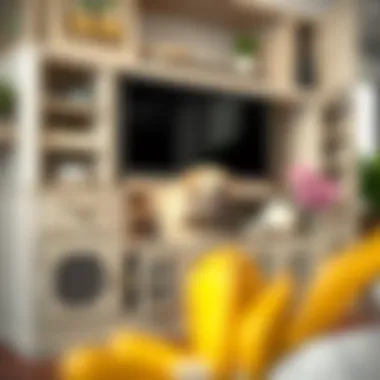
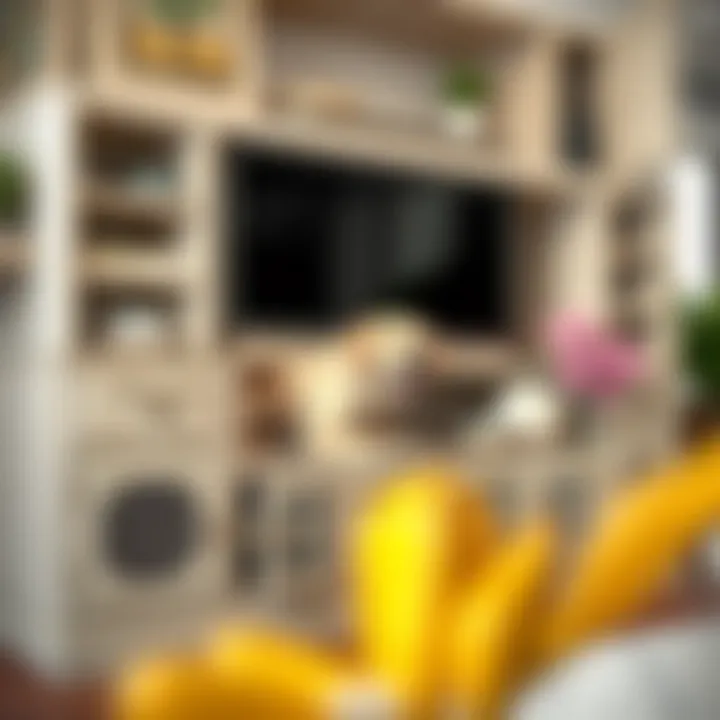
- Built-in Units: Design an elaborate built-in that houses an entertainment system on top with a cozy dog apartment beneath. This not only saves space but creates an eye-catching focal point.
- Convertible Furniture: Furniture that transforms can be incredibly useful. For example, a coffee table that opens to reveal a small enclosure for a pet when needed, but looks like a designer piece when closed.
- Hidden Compartments: Imagine a stylish console table that pops open to reveal a dedicated area for dog essentials like leashes or toys, coupled with a cozy cage design integrated into the base.
In all these creative layouts, functionality is key. The goal is to create an environment where both humans and pets thrive. This thoughtfulness in design not only enhances aesthetics but furthers a sense of belonging for pets within the home, making them part of the family rather than an afterthought.
Overall, innovative designs in integrating entertainment centers and dog cages not only enhance the family's lifestyle but also serve to elevate the overall ambiance of the home.
Selecting the Right Materials
Choosing the right materials for integrating entertainment centers and dog cages is more than just a matter of aesthetics—it's about ensuring longevity, functionality, and safety. Homeowners today are increasingly focused on how their choices impact both their living space and their pets' well-being. The materials you select can significantly influence the overall feel of your home, as well as how well the space functions for daily use.
Durable vs. Aesthetic Choices
When selecting materials, a careful balance must be struck between durability and aesthetic appeal.
- Durability: It's essential to choose materials that can withstand the test of time and the rigors of pet ownership. Solid woods like oak or maple are often favored for their strength and longevity. These materials can handle the wear and tear of an active pet, ensuring the entertainment center retains its integrity over the years.
- Aesthetic Choices: Homeowners also want pieces that complement their interior design. Open-grain woods, for example, can add a rustic charm, while sleek, molded plastics may cater to a more contemporary look. The key is to find surfaces that match your tastes while still holding up against daily use and the occasional accidental bump from a playful pup.
In selecting materials, consider the following:
- Finishes: Look for finishes that provide protection against scratches and stains. Whether you choose a matte or glossy finish can affect how the furniture looks and feels in your space.
- Colors: Choose colors that not only fit your existing decor but also hide potential fur and dirt. Darker shades might disguise pet hair better than lighter ones.
- Blending Styles: When combining elements of both dog cages and entertainment centers, materials should harmonize to create a cohesive appearance. A metal frame with wooden shelving can add an industrial yet warm vibe, while glass accents might introduce a modern touch.
Eco-Friendly Options
Sustainability is also a major consideration when selecting materials. More homeowners are opting for eco-friendly solutions, recognizing their impact on the environment.
- Reclaimed Materials: Using reclaimed wood from old buildings not only gives new life to discarded materials but often results in unique pieces that tell a story. Reclaimed woods can introduce character into the home while also being environmentally conscious.
- Bamboo and Cork: Both bamboo and cork are excellent alternative choices due to their rapid renewability. Bamboo grows back quickly after harvesting, making it a highly sustainable option. Cork is derived from the bark of cork oak trees, which can be harvested without harming the tree itself. Its natural resilience makes it a fitting choice for pet areas as well.
Engaging with sustainable options often means engaging with your community too. Local artisans might provide unique handmade pieces that align with eco-friendly practices, fostering a sense of connection to your community while supporting sustainable practices.
Health and Safety Aspects
In integrating entertainment centers with dog cages, the underlying layers of health and safety cannot be overlooked. Safety isn't just a term tossed around; it is a vital foundation for a comfortable living space—especially when pets are involved. The realities of having a pet alongside the wear and tear of human activities require a holistic approach to ensure that both aesthetics and safety coalesce seamlessly. By addressing specific health risks and ensuring a safe environment, homeowners can create spaces that accommodate both pets and people without compromising well-being.
Preventing Injury to Pets
When it comes to furniture that serves dual purposes, understanding how to prevent injuries to pets is crucial. Dogs, especially rambunctious puppies, have a knack for getting themselves into trouble. Spaces that seem otherwise benign may pose hazards to their safety. The integration of entertainment centers and dog cages must prioritize a pet's physical safety above all.
- Material Safety: Choosing materials that are non-toxic is paramount. Many common woods and finishes contain harmful chemicals. Opting for natural materials not only ensures durability but also reduces the risk of exposure to hazardous substances.
- Design Considerations: The structural integrity of the combined furniture should prevent any chance of tipping. A stable piece will ensure that playful antics don’t lead to accidents. The corners and edges of the entertainment center could be rounded or padded to avoid injuries from rough housing.
- Secure Hideaways: If the dog cage is part of the entertainment center, ensuring that there are no small spaces where limbs could get stuck is essential. Evaluate the designs thoroughly for potential entrapment risks.
"Safety is not just a product of smart design; it's about creating an environment where our furry companions can thrive without fear."
Ensuring Adequate Ventilation
Another pivotal component of health and safety in this context is ensuring adequate ventilation. While it’s tempting to create a cozy nook for our pets within the entertainment furniture, we mustn't forget that proper airflow is vital for their health.
- Air Circulation: Good airflow prevents overheating, which can be particularly critical during warmer months. If a dog cage is enclosed within a bulky entertainment system, it might not have adequate ventilation unless designed specifically for this purpose.
- Materials and Openings: Incorporate mesh openings or grills into the design of a combined space to facilitate airflow. A well-ventilated dog area not only improves comfort but also minimizes stress for the pet, which in turn encourages a healthier, happier environment.
- Monitoring Temperature: It's wise for homeowners to monitor the temperatures in these spaces. By incorporating temperature readers, owners can stay informed and make adjustments as necessary—whether it be through fans, air conditioning, or simply by leaving the door open.
Creating a harmonious and safe living space that accommodates both entertainment and pet needs requires careful consideration of health and safety aspects. Balancing comfort for pets with the aesthetic desires of homeowners demands thorough planning and awareness of the unique challenges that arise from this integration.
Maintenance and Care Guidelines
Maintaining multifunctional furniture, particularly those pieces that combine entertainment centers and dog cages, is crucial for preserving their integrity and functionality. Such furniture acts as the backbone of modern homes, serving dual purposes that enhance living spaces. Regular maintenance ensures that these items remain safe for pets and enjoyable for humans, ultimately extending their lifespan.
Investing time in care can prevent costly repairs, while ensuring the aesthetics align with your home’s décor. The right maintenance practices not only keep your furniture looking great but also promote a safe environment for pets, which is a non-negotiable priority for responsible pet owners.
Cleaning Recommendations for Wood and Fabric
Cleaning wood and fabric materials in multifunctional furniture involves distinct techniques to protect them and ensure they last longer. Here are some critical tips:
- For Wood:
- For Fabric:
- Use a soft, lint-free cloth to wipe away dust. Microfiber cloths are ideal as they trap particles without scratching the surface.
- Occasionally apply a wood conditioner or polish that is appropriate for the wood type. This can help maintain its sheen and prevent dryness. Avoid using too much water, as excess moisture can warp the wood.
- If your entertainment center has an integrated dog cage, ensure you clean the cage section separately with a disinfectant safe for animals, since odors can become entrenched.
- Regular vacuuming is essential for fabric sections to remove hair and dirt. Use the upholstery attachment on your vacuum cleaner.
- Spot clean any stains immediately, using a mixture of mild soap and water; for tougher stains, consider professional cleaning solutions that are safe for pets.
- Always check and follow the manufacturer’s cleaning instructions to avoid damaging the fabric.
Routine Inspections for Safety
Aside from regular cleaning, undertake routine inspections to ensure that your multifunctional furniture remains safe. Here’s how you can ensure both the entertainment and dog-cage components stay in tip-top shape:
- Check for Wear and Tear: Look for any signs of damage, such as rattling doors, loose hinges, or fraying fabric. Early detection of these issues can prevent accidents down the line.
- Ensure Stability: Rock or shake the furniture gently to test its stability. If it feels wobbly or unstable, you may need to reinforce it or consider repairs.
- Inspect for Hazards: Ensure that there are no small detachable parts or sharp edges that could pose a risk to curious pets.
- Ventilation Checks: Make sure the dog cage section has proper ventilation; inspect the air flow, as inadequate circulation can lead to discomfort for your furry friend.
> "A stitch in time saves nine." Regular inspections can save you from significant troubles later on, ensuring safety and enhancing the lifespan of your furniture.
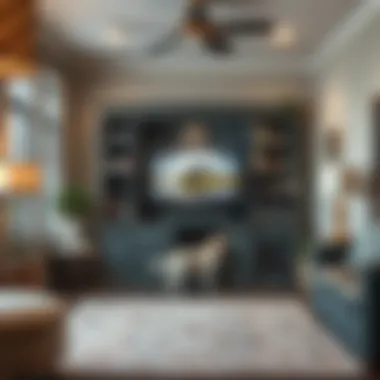

Alternatives to Traditional Entertainment Centers
As the needs of modern homeowners evolve, so does the furniture that populates our living spaces. This section explores how alternatives to traditional entertainment centers are not just a trend but an essential shift in design philosophy. Traditional entertainment centers often prioritize aesthetics over functionality, leaving little room for pet-friendly features. However, the rise of multifunctional furniture provides a valuable escape from this paradigm, combining style with practicality in a single piece.
Versatile Furniture Solutions
The market has seen a boom in versatile furniture solutions that balance elegance and utility. Here are some aspects that underscore their importance:
- Space-Saving Designs: Furniture such as wall-mounted panels or modular shelves can not only house a television but also incorporate storage for dog-related items like leashes, toys, and food. This compact design is ideal for smaller homes where every inch counts.
- Customizable Options: Many manufacturers now offer customizable furniture pieces. For example, a unit can be designed to include a cozy nook for a dog bed or a space for a crate, ensuring that pets are included in the home's aesthetic.
- Multi-Functionality: Rather than a bulky entertainment center that serves one purpose, consider a hybrid piece that can act as a TV stand, storage for media, and a stylish dog enclosure all in one. It addresses the need for a lovely display while keeping furry members secure.
"Innovation in furniture design allows us to create a more cohesive living space that welcomes both style and our beloved pets."
Portable Dog Cages
One notable shift in pet care is the acceptance and incorporation of portable dog cages into the home environment. Unlike the traditional, standalone cages that often clashed with home décor, portable options blend seamlessly within multifunctional furniture. Here are key points to consider:
- Mobility and Ease of Use: Portable dog cages can easily be moved around the house or taken on trips, making them a practical solution for owners who travel frequently. This kind of flexibility means pets have a safe space no matter where they are.
- Design Integration: These cages come in various designs and colors, allowing them to fit in well with other furniture. Some may even mimic the look of decorative baskets or stylish furniture pieces, ensuring they don’t disrupt the aesthetic of a space.
- Enhanced Comfort and Safety: Many portable cages are designed with the pet's comfort in mind. Materials are often breathable and cushioned, creating a cozy spot while ensuring safety for the pet.
Ultimately, the trends toward versatile furniture solutions and portable dog cages emphasize how modern design is evolving. This shift accommodates both the functional requirements of pet ownership and the undying desire for a stylish home, proving that form and function can coexist harmoniously.
Trends in Home Decor and Pet Ownership
In today's evolving living spaces, the integration of pet-friendly features in home design has become a hot topic. The modern homeowner increasingly prioritizes aspects that combine the joys of pet ownership with the aesthetics of their surroundings. This trend is not just an aesthetic choice; it signifies a deeper understanding of how pets influence our daily lives and household dynamics.
Home decor is no longer purely about looks; it’s about creating a harmonious living environment where pets can thrive just as much as their owners. As more people adopt pets, especially in urban settings, there is a noticeable shift towards multifunctional furniture that accommodates both style and the needs of our furry companions. It’s a win-win situation: homeowners gain functional living spaces, while pets enjoy more freedom and comfort.
Shifts in Consumer Preferences
Interestingly, the rise of social media and lifestyle blogs has really transformed how people think about pet ownership and home design. Pet owners now seek out designs that reflect their personalities and lifestyles. For instance, rather than tucking away pet beds or cages in remote corners, many choose to incorporate them into more visible areas of the home. This trend highlights an important shift in consumer preferences; pets are no longer seen just as additions to the family but as integral to the family unit itself.
Here are a few noteworthy shifts:
- Preference for Open Spaces: Homeowners are favoring more open floor plans that promote interaction between pets and family members.
- Durable Materials: With active pets running around, there’s an increasing demand for furniture made from materials that can withstand wear and tear while remaining stylish.
- Stylish Pet Accessories: Instead of traditional cages, consumers opt for designer crates and beds that blend with their decor rather than clash with it.
The Influence of Aesthetic Appeal on Functionality
When considering the design of home furnishings, it’s clear that aesthetics and functionality need to go hand in hand. The best solutions are those that don’t compromise on either front. Homeowners are looking for pieces that are not only practical but also elevate the visual appeal of the space. A well-designed entertainment center that also serves as a dog cage can seamlessly blend in with the rest of the decor, rather than sticking out like a sore thumb.
Several factors contribute to this growing trend:
- Customization Options: Many brands now offer customizable furniture that allows homeowners to select colors, materials, and sizes that best fit their decor schemes.
- Versatile Designs: Modular furniture that can adapt to changing spaces or serve multiple functions is becoming more popular. For this reason, a unit that offers storage for media while housing a dog crate is seen as ingenious.
- Visual Harmony: Stylish furniture pieces encourage homeowners to integrate practical solutions with their interior design. For example, a well-structured entertainment unit housing an aesthetically pleasing dog cage can draw the eye, rather than detract from the overall decor.
"Combining aesthetic appeal with functionality in pet furniture is no longer a novelty; it has become a necessary consideration in modern home design."
The shifting landscape in home decor signifies a new era of pet ownership, where our beloved companions are celebrated as a key part of the family life. The interplay between design and practicality not only enhances living environments but also enriches the lives of pets and owners alike.
End: Achieving a Harmonious Living Space
In the quest for a cohesive and aesthetically-pleasing home, integrating entertainment centers and dog cages presents a unique opportunity. This era of multifunctional furniture is not just a fad; it’s a necessity for homeowners who seek both style and practicality. The essence of this integration lies in the ability to create spaces that cater to both the visual appeal of modern design and the comfort of beloved pets.
Creating a harmonious living space hinges on balanced design and functionality. When an entertainment center serves a dual purpose as a dog cage, it can mesh seamlessly into a living room or family area without compromising style. Homeowners can select colors, patterns, and materials that compliment their decor, ensuring that aesthetics do not take a backseat to practicality.
Moreover, the choice of materials plays a pivotal role. Opting for sturdy yet stylish woods, or selecting eco-friendly metals ensures durability while also aligning with sustainable practices. Here are some key considerations:
- Visual cohesion: Pick designs that complement other furnishings to create a unified look.
- Size and scale: Ensure the combined unit doesn’t overwhelm the room, maintaining an open and welcoming atmosphere.
- Accessibility and comfort for pets: Make sure the area is comfortable, allowing pets to feel at home even within a piece of furniture.
“A well-designed space reflects the needs and tastes of its occupants, blending form with function effortlessly.”
The integration of these elements fosters a sense of balance and peace in the home. Moreover, it signals a shift toward a lifestyle where the well-being of pets and aesthetic desires can coexist. A multifaceted piece of furniture stands as a testament to the forward-thinking nature of modern design.
Balancing Style with Practicality
In today’s design landscape, balancing style with practicality is akin to walking a tightrope. Homeowners need to consider how a furniture piece looks while also ensuring it meets functional needs. It is a tall order, yet, it is achievable. When it comes to entertainment centers that double as pet enclosures, this balance manifests in various ways.
First, it’s essential to consider how the product fits into the aesthetic of the home. A chic, sleek design can enhance the decor while still providing a proper habitat for pets. Traditional wooden enclosures can evoke warmth, while modern sleek designs can cater to more contemporary tastes. Finding a middle ground ensures that both pet comfort and human needs are considered.
Second, functionality should not be overlooked; these spaces need to be practical. Features like removable trays for easy cleaning or ventilation systems ensure pets’ health while also making upkeep a breeze. Homeowners will appreciate designs that facilitate easy access for both humans and pets, allowing for seamless interaction without hassle.
To achieve this balance, homeowners might ask themselves:
- Is the furniture easy to clean?
- Does it promote the pet’s health with proper ventilation?
- Does it blend effortlessly with existing decor?
Future of Multifunctional Furniture
As we look ahead, the future of multifunctional furniture seems bright and promising. The integration of entertainment centers and dog cages is just the tip of the iceberg. With increasing urbanization and smaller living spaces, homeowners will continue seeking innovative solutions that maximize space while serving multiple purposes. The rising trend of multifunctional pieces indicates a thoughtful approach to design that prioritizes efficiency without skimping on style.
One can expect to see the following developments:
- Customizable features: As technology advances, consumers will increasingly enjoy tailor-made pieces that can adapt to various needs, whether it’s size, style, or function.
- Smart furniture: Integration of technology will allow homeowners to control elements like temperature and ventilation remotely through apps.
- Sustainability focus: The push toward eco-friendly materials is unlikely to diminish. Instead, we may see more innovations made from sustainable resources that don’t compromise quality.













